Analytical Journal of a Mediation Session - Conflict Resolution
VerifiedAdded on 2022/11/01
|8
|2297
|248
Journal and Reflective Writing
AI Summary
This analytical journal provides a detailed reflection on a mediation session conducted by the author, who acted as a Personnel Manager resolving a conflict between two employees. The journal meticulously examines the situation, which involved personality clashes, differing work styles, and cultural disagreements. The author employed behavioral therapy and cognitive theories to understand the employees' behaviors and mental thoughts, guiding the mediation process. The action section outlines the techniques used, including critical listening and interrogation, to gather information and facilitate resolution. The reflection section highlights the success of the mediation, attributing it to the application of counseling techniques, theoretical frameworks, and mediation strategies such as effective interpersonal communication and empathy. The author emphasizes the importance of compromise and the win-win strategy in achieving a successful outcome, demonstrating the practical application of leadership and conflict resolution skills.
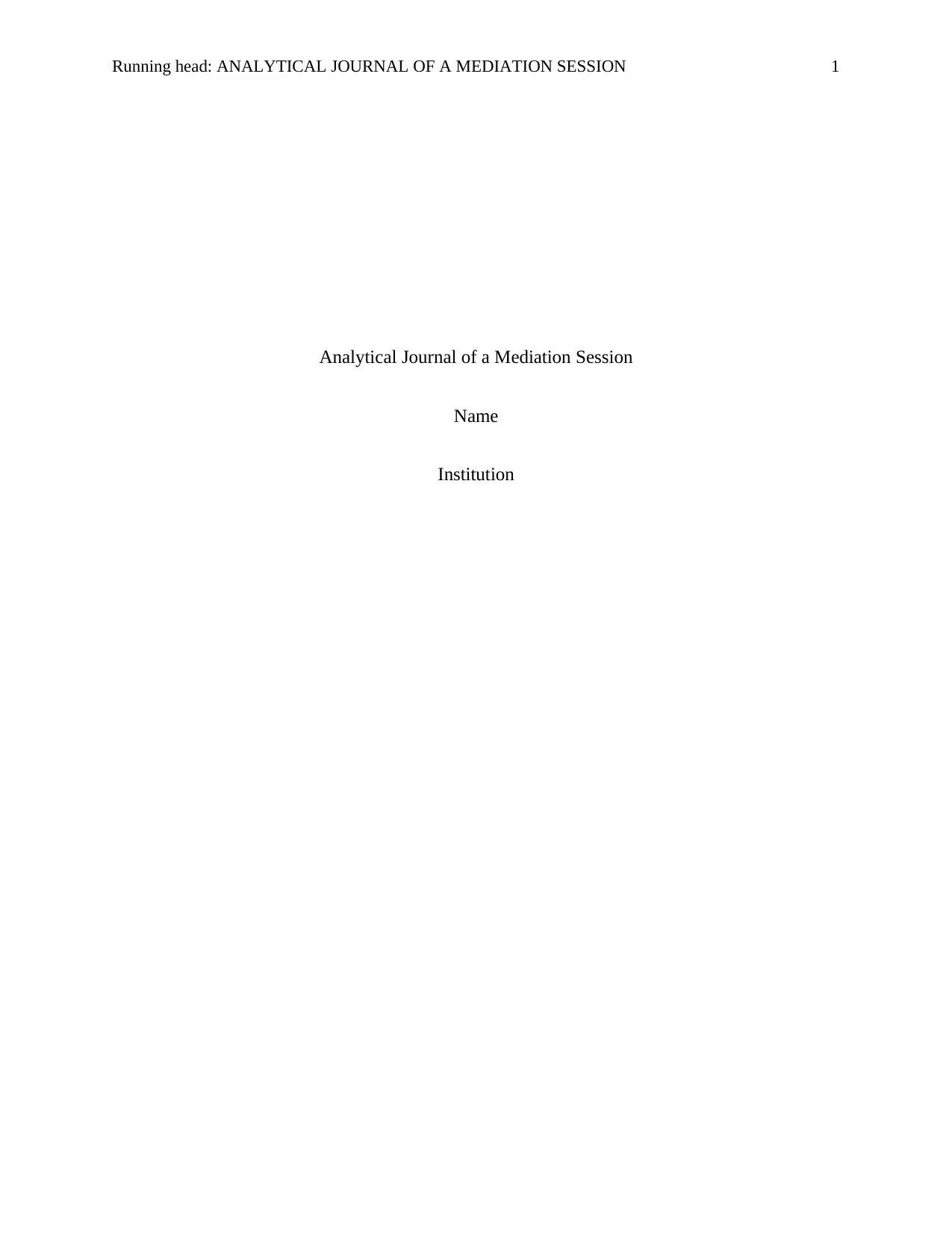
Running head: ANALYTICAL JOURNAL OF A MEDIATION SESSION 1
Analytical Journal of a Mediation Session
Name
Institution
Analytical Journal of a Mediation Session
Name
Institution
Paraphrase This Document
Need a fresh take? Get an instant paraphrase of this document with our AI Paraphraser
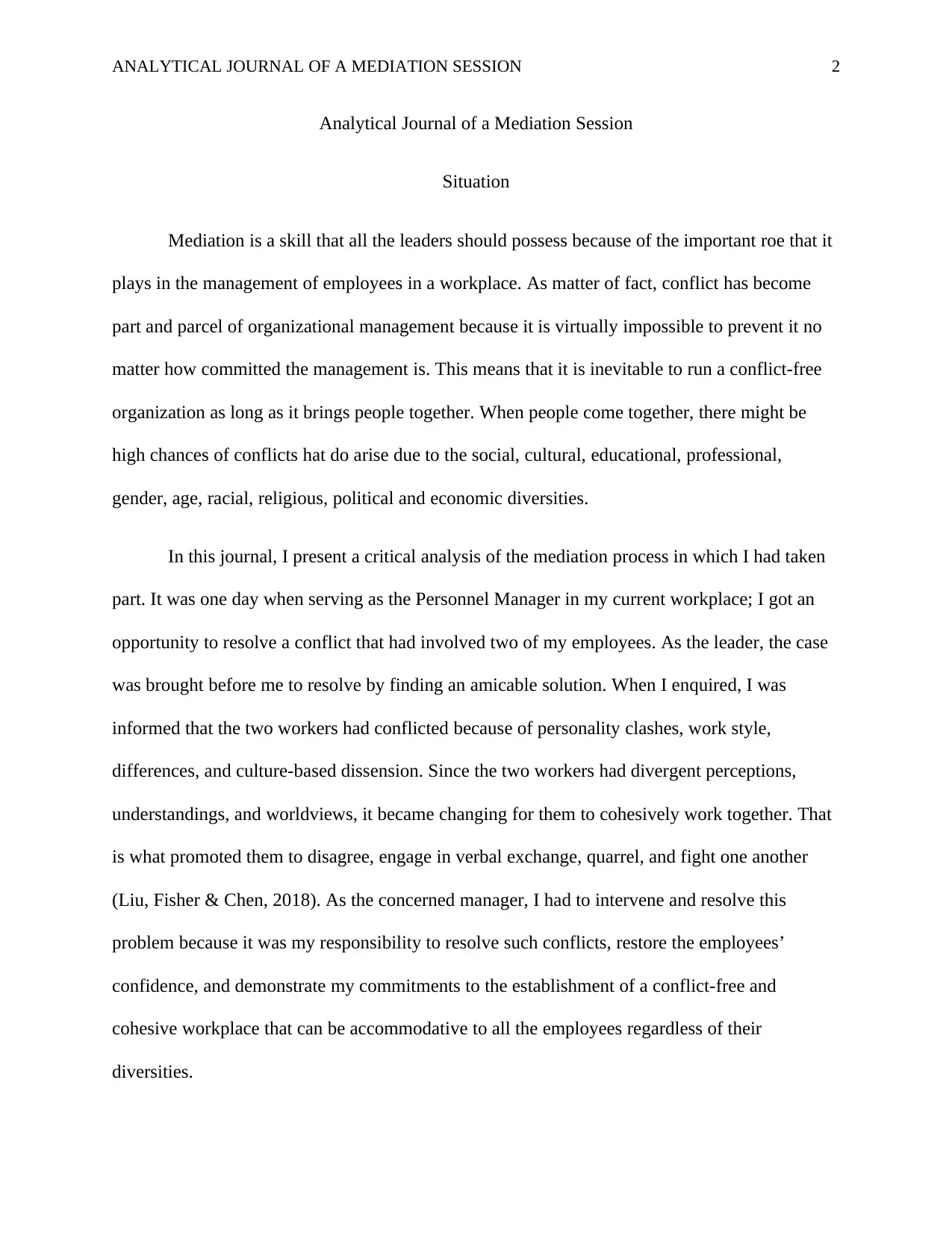
ANALYTICAL JOURNAL OF A MEDIATION SESSION 2
Analytical Journal of a Mediation Session
Situation
Mediation is a skill that all the leaders should possess because of the important roe that it
plays in the management of employees in a workplace. As matter of fact, conflict has become
part and parcel of organizational management because it is virtually impossible to prevent it no
matter how committed the management is. This means that it is inevitable to run a conflict-free
organization as long as it brings people together. When people come together, there might be
high chances of conflicts hat do arise due to the social, cultural, educational, professional,
gender, age, racial, religious, political and economic diversities.
In this journal, I present a critical analysis of the mediation process in which I had taken
part. It was one day when serving as the Personnel Manager in my current workplace; I got an
opportunity to resolve a conflict that had involved two of my employees. As the leader, the case
was brought before me to resolve by finding an amicable solution. When I enquired, I was
informed that the two workers had conflicted because of personality clashes, work style,
differences, and culture-based dissension. Since the two workers had divergent perceptions,
understandings, and worldviews, it became changing for them to cohesively work together. That
is what promoted them to disagree, engage in verbal exchange, quarrel, and fight one another
(Liu, Fisher & Chen, 2018). As the concerned manager, I had to intervene and resolve this
problem because it was my responsibility to resolve such conflicts, restore the employees’
confidence, and demonstrate my commitments to the establishment of a conflict-free and
cohesive workplace that can be accommodative to all the employees regardless of their
diversities.
Analytical Journal of a Mediation Session
Situation
Mediation is a skill that all the leaders should possess because of the important roe that it
plays in the management of employees in a workplace. As matter of fact, conflict has become
part and parcel of organizational management because it is virtually impossible to prevent it no
matter how committed the management is. This means that it is inevitable to run a conflict-free
organization as long as it brings people together. When people come together, there might be
high chances of conflicts hat do arise due to the social, cultural, educational, professional,
gender, age, racial, religious, political and economic diversities.
In this journal, I present a critical analysis of the mediation process in which I had taken
part. It was one day when serving as the Personnel Manager in my current workplace; I got an
opportunity to resolve a conflict that had involved two of my employees. As the leader, the case
was brought before me to resolve by finding an amicable solution. When I enquired, I was
informed that the two workers had conflicted because of personality clashes, work style,
differences, and culture-based dissension. Since the two workers had divergent perceptions,
understandings, and worldviews, it became changing for them to cohesively work together. That
is what promoted them to disagree, engage in verbal exchange, quarrel, and fight one another
(Liu, Fisher & Chen, 2018). As the concerned manager, I had to intervene and resolve this
problem because it was my responsibility to resolve such conflicts, restore the employees’
confidence, and demonstrate my commitments to the establishment of a conflict-free and
cohesive workplace that can be accommodative to all the employees regardless of their
diversities.

ANALYTICAL JOURNAL OF A MEDIATION SESSION 3
Theory/Technique
When I got an opportunity to preside over this case, I knew that I had a challenging task
to undertake. However, as an experienced mediator, I could not shy away because it was another
chance to display my mediation prowess. What I did, hence, was to employ the use of the
appropriate theoretical frameworks that would enable me to successfully resolve the personality
clashes, work style, differences, and culture-based dissension conflict that was threatening to tear
the organization into pieces. To effectively mediate in this situation, I had to apply two theories:
behavioural therapy theory, and cognitive theory.
Behavioural is a theory which focuses on the management of individual behaviours.
According to this theory, behaviour is not innate, but acquired as one grows and interacts with
the immediate environment. This means that one’s behaviour is a true reflection of one’s
immediate surroundings. So, just the same way behaviour is learnt, it can be unlearnt (Alen,
2018). I had to apply this theory during my mediation because of the significant contribution it
played in determining the success of my mediation. The first why through which I used has
theory was to understand the kinds of behaviours that had been displayed by the two employees.
A thorough analysis of this aspect enabled me to know exactly what made the two to disagree
and engage in a conflict. Besides, I used the theory to understand and make a decision on how
behaviour can be unlearnt (Mafirja, Wibowo & Sunawan, 2018). So, what I did is that I had to
provide the necessary guidance to the employees to consider reforming their stance especially
when dealing with others who are diverse in one way or the other.
Cognitive theory is an approach that focuses on the analysis of individuals’ mentality ad
mental thought. Each person has cognitive capabilities that enable them to think, behaviour, and
Theory/Technique
When I got an opportunity to preside over this case, I knew that I had a challenging task
to undertake. However, as an experienced mediator, I could not shy away because it was another
chance to display my mediation prowess. What I did, hence, was to employ the use of the
appropriate theoretical frameworks that would enable me to successfully resolve the personality
clashes, work style, differences, and culture-based dissension conflict that was threatening to tear
the organization into pieces. To effectively mediate in this situation, I had to apply two theories:
behavioural therapy theory, and cognitive theory.
Behavioural is a theory which focuses on the management of individual behaviours.
According to this theory, behaviour is not innate, but acquired as one grows and interacts with
the immediate environment. This means that one’s behaviour is a true reflection of one’s
immediate surroundings. So, just the same way behaviour is learnt, it can be unlearnt (Alen,
2018). I had to apply this theory during my mediation because of the significant contribution it
played in determining the success of my mediation. The first why through which I used has
theory was to understand the kinds of behaviours that had been displayed by the two employees.
A thorough analysis of this aspect enabled me to know exactly what made the two to disagree
and engage in a conflict. Besides, I used the theory to understand and make a decision on how
behaviour can be unlearnt (Mafirja, Wibowo & Sunawan, 2018). So, what I did is that I had to
provide the necessary guidance to the employees to consider reforming their stance especially
when dealing with others who are diverse in one way or the other.
Cognitive theory is an approach that focuses on the analysis of individuals’ mentality ad
mental thought. Each person has cognitive capabilities that enable them to think, behaviour, and
⊘ This is a preview!⊘
Do you want full access?
Subscribe today to unlock all pages.

Trusted by 1+ million students worldwide
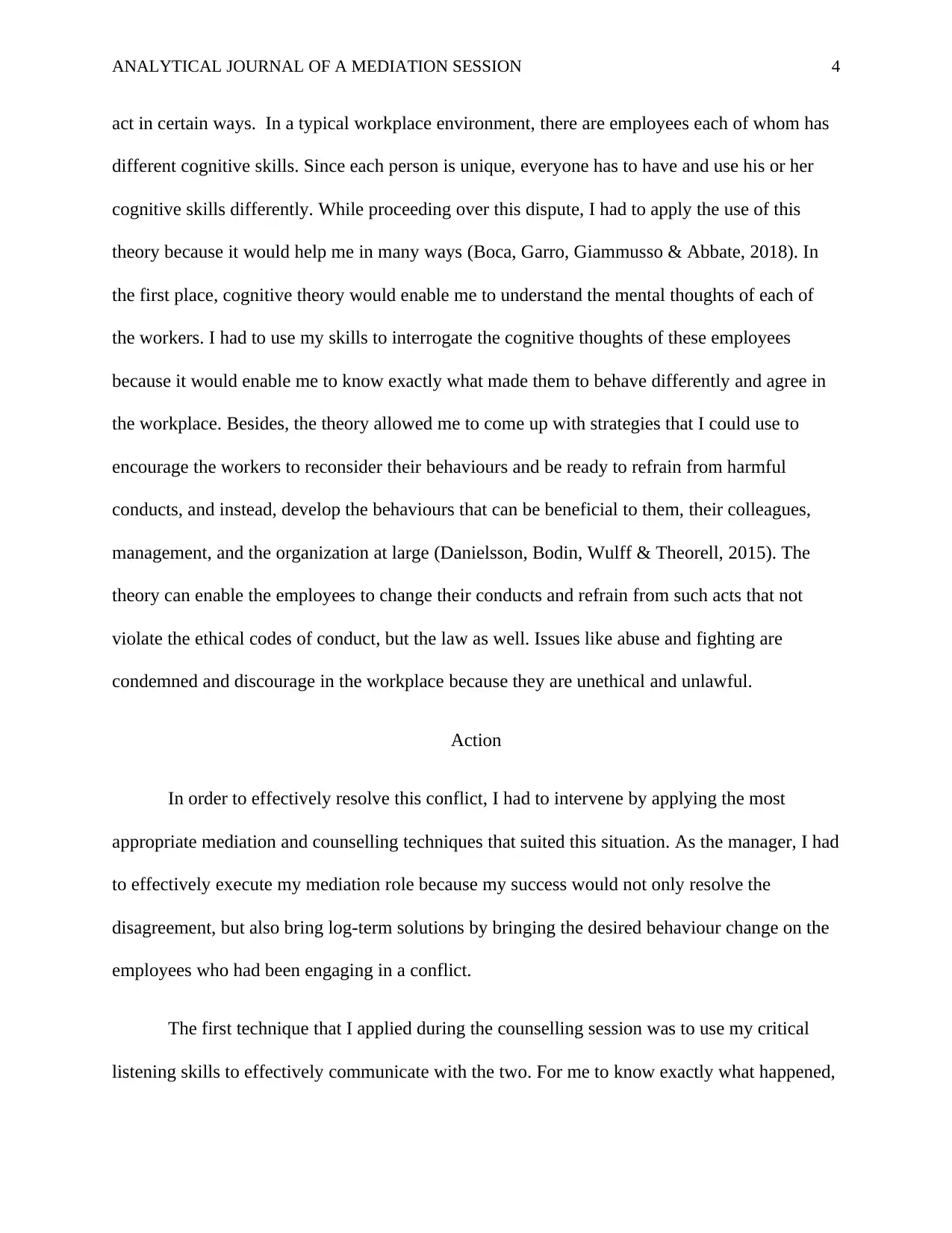
ANALYTICAL JOURNAL OF A MEDIATION SESSION 4
act in certain ways. In a typical workplace environment, there are employees each of whom has
different cognitive skills. Since each person is unique, everyone has to have and use his or her
cognitive skills differently. While proceeding over this dispute, I had to apply the use of this
theory because it would help me in many ways (Boca, Garro, Giammusso & Abbate, 2018). In
the first place, cognitive theory would enable me to understand the mental thoughts of each of
the workers. I had to use my skills to interrogate the cognitive thoughts of these employees
because it would enable me to know exactly what made them to behave differently and agree in
the workplace. Besides, the theory allowed me to come up with strategies that I could use to
encourage the workers to reconsider their behaviours and be ready to refrain from harmful
conducts, and instead, develop the behaviours that can be beneficial to them, their colleagues,
management, and the organization at large (Danielsson, Bodin, Wulff & Theorell, 2015). The
theory can enable the employees to change their conducts and refrain from such acts that not
violate the ethical codes of conduct, but the law as well. Issues like abuse and fighting are
condemned and discourage in the workplace because they are unethical and unlawful.
Action
In order to effectively resolve this conflict, I had to intervene by applying the most
appropriate mediation and counselling techniques that suited this situation. As the manager, I had
to effectively execute my mediation role because my success would not only resolve the
disagreement, but also bring log-term solutions by bringing the desired behaviour change on the
employees who had been engaging in a conflict.
The first technique that I applied during the counselling session was to use my critical
listening skills to effectively communicate with the two. For me to know exactly what happened,
act in certain ways. In a typical workplace environment, there are employees each of whom has
different cognitive skills. Since each person is unique, everyone has to have and use his or her
cognitive skills differently. While proceeding over this dispute, I had to apply the use of this
theory because it would help me in many ways (Boca, Garro, Giammusso & Abbate, 2018). In
the first place, cognitive theory would enable me to understand the mental thoughts of each of
the workers. I had to use my skills to interrogate the cognitive thoughts of these employees
because it would enable me to know exactly what made them to behave differently and agree in
the workplace. Besides, the theory allowed me to come up with strategies that I could use to
encourage the workers to reconsider their behaviours and be ready to refrain from harmful
conducts, and instead, develop the behaviours that can be beneficial to them, their colleagues,
management, and the organization at large (Danielsson, Bodin, Wulff & Theorell, 2015). The
theory can enable the employees to change their conducts and refrain from such acts that not
violate the ethical codes of conduct, but the law as well. Issues like abuse and fighting are
condemned and discourage in the workplace because they are unethical and unlawful.
Action
In order to effectively resolve this conflict, I had to intervene by applying the most
appropriate mediation and counselling techniques that suited this situation. As the manager, I had
to effectively execute my mediation role because my success would not only resolve the
disagreement, but also bring log-term solutions by bringing the desired behaviour change on the
employees who had been engaging in a conflict.
The first technique that I applied during the counselling session was to use my critical
listening skills to effectively communicate with the two. For me to know exactly what happened,
Paraphrase This Document
Need a fresh take? Get an instant paraphrase of this document with our AI Paraphraser

ANALYTICAL JOURNAL OF A MEDIATION SESSION 5
I had to be a critical listener. Here, I had to take my time to listen to everything that the two had
to say. I gave each f them enough time to express themselves without unnecessarily interrupting
them. At the same time, I applied the principle of respect while communicating with them (Gilin
Oore, Leiter & LeBlanc, 2015).). I had to demonstrate a high-degree of respect to the two no
matter the content of the message they were delivering to me. A through listening to each of the
two employees was a good idea because it helped me a lot (Ahmed, 2016). I got to gather all the
necessary information that I was to use to make a decision on the right guidelines that I was to
apply in the making of conclusion so as to resolve the conflict and bring it to an end.
The second technique that I applied when resolving the conflict is interrogation. As an
experienced mediator, I acknowledge the fact that the success of the mediation process relies on
the interrogation prowess of the mediator. Interrogation is crucial because it helps in the
questioning of the clients in order to gather all the information that is needed to make a decision
regarding the issue at hand. What I did, in this regard, was to create time to interrogate each of
the employees (Robitschek & Hardin, 2017). During this time, I had to apply my skills to
interview the employees by asking them a range of questions to get their views on the cause,
course, and the effects of the disagreement that they had. However, to succeed in my
interrogations, I had to make a proper use of verbal and non-verbal communication skills
(Grzanka, Santos & Moradi, 2017). At the same time, I had to incorporate other useful
competencies like empathy, tolerance, fairness, and appreciation. All these enabled me to
successfully resolve the conflict by bringing peace between the two workers who had disagreed.
Reflection
I had to be a critical listener. Here, I had to take my time to listen to everything that the two had
to say. I gave each f them enough time to express themselves without unnecessarily interrupting
them. At the same time, I applied the principle of respect while communicating with them (Gilin
Oore, Leiter & LeBlanc, 2015).). I had to demonstrate a high-degree of respect to the two no
matter the content of the message they were delivering to me. A through listening to each of the
two employees was a good idea because it helped me a lot (Ahmed, 2016). I got to gather all the
necessary information that I was to use to make a decision on the right guidelines that I was to
apply in the making of conclusion so as to resolve the conflict and bring it to an end.
The second technique that I applied when resolving the conflict is interrogation. As an
experienced mediator, I acknowledge the fact that the success of the mediation process relies on
the interrogation prowess of the mediator. Interrogation is crucial because it helps in the
questioning of the clients in order to gather all the information that is needed to make a decision
regarding the issue at hand. What I did, in this regard, was to create time to interrogate each of
the employees (Robitschek & Hardin, 2017). During this time, I had to apply my skills to
interview the employees by asking them a range of questions to get their views on the cause,
course, and the effects of the disagreement that they had. However, to succeed in my
interrogations, I had to make a proper use of verbal and non-verbal communication skills
(Grzanka, Santos & Moradi, 2017). At the same time, I had to incorporate other useful
competencies like empathy, tolerance, fairness, and appreciation. All these enabled me to
successfully resolve the conflict by bringing peace between the two workers who had disagreed.
Reflection
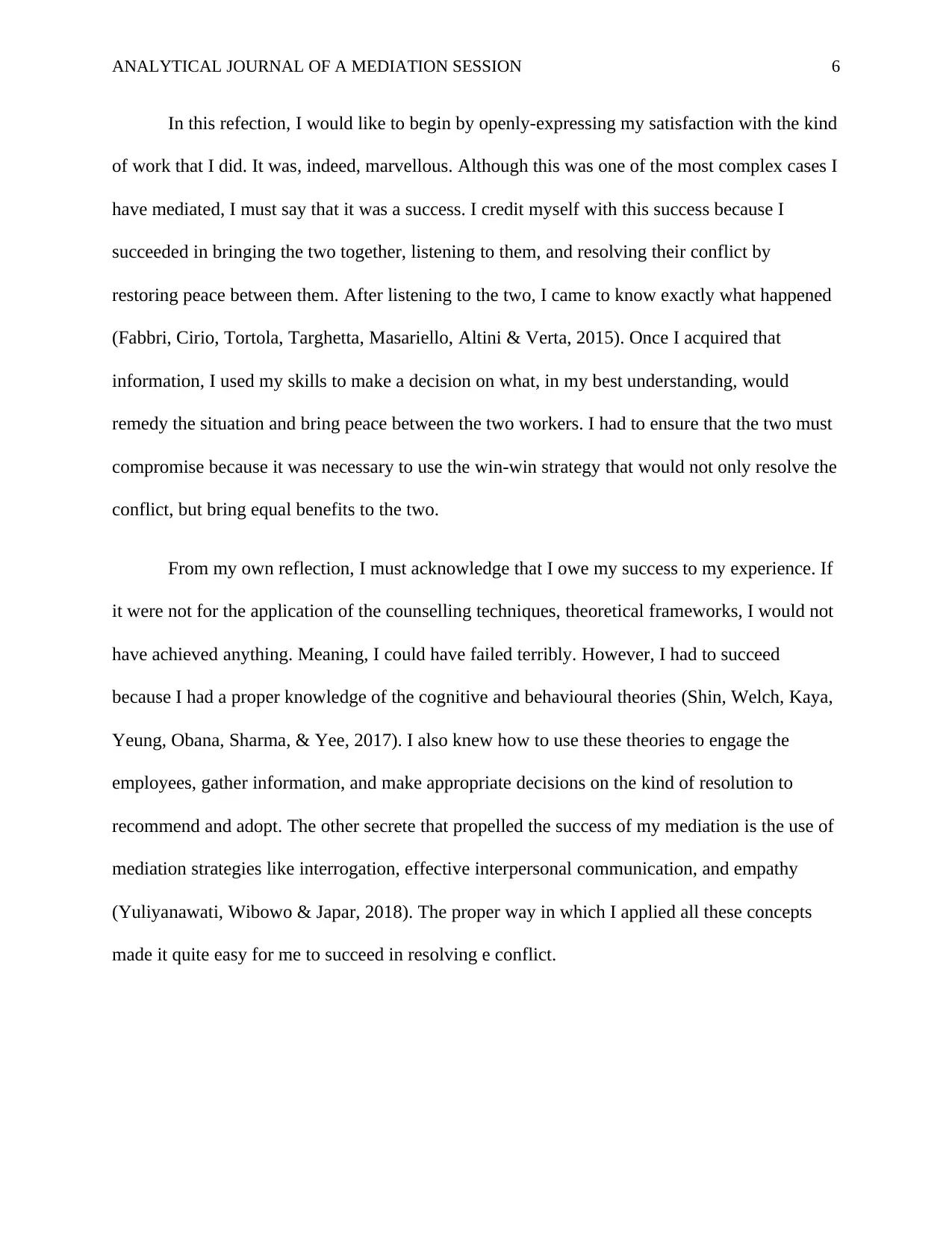
ANALYTICAL JOURNAL OF A MEDIATION SESSION 6
In this refection, I would like to begin by openly-expressing my satisfaction with the kind
of work that I did. It was, indeed, marvellous. Although this was one of the most complex cases I
have mediated, I must say that it was a success. I credit myself with this success because I
succeeded in bringing the two together, listening to them, and resolving their conflict by
restoring peace between them. After listening to the two, I came to know exactly what happened
(Fabbri, Cirio, Tortola, Targhetta, Masariello, Altini & Verta, 2015). Once I acquired that
information, I used my skills to make a decision on what, in my best understanding, would
remedy the situation and bring peace between the two workers. I had to ensure that the two must
compromise because it was necessary to use the win-win strategy that would not only resolve the
conflict, but bring equal benefits to the two.
From my own reflection, I must acknowledge that I owe my success to my experience. If
it were not for the application of the counselling techniques, theoretical frameworks, I would not
have achieved anything. Meaning, I could have failed terribly. However, I had to succeed
because I had a proper knowledge of the cognitive and behavioural theories (Shin, Welch, Kaya,
Yeung, Obana, Sharma, & Yee, 2017). I also knew how to use these theories to engage the
employees, gather information, and make appropriate decisions on the kind of resolution to
recommend and adopt. The other secrete that propelled the success of my mediation is the use of
mediation strategies like interrogation, effective interpersonal communication, and empathy
(Yuliyanawati, Wibowo & Japar, 2018). The proper way in which I applied all these concepts
made it quite easy for me to succeed in resolving e conflict.
In this refection, I would like to begin by openly-expressing my satisfaction with the kind
of work that I did. It was, indeed, marvellous. Although this was one of the most complex cases I
have mediated, I must say that it was a success. I credit myself with this success because I
succeeded in bringing the two together, listening to them, and resolving their conflict by
restoring peace between them. After listening to the two, I came to know exactly what happened
(Fabbri, Cirio, Tortola, Targhetta, Masariello, Altini & Verta, 2015). Once I acquired that
information, I used my skills to make a decision on what, in my best understanding, would
remedy the situation and bring peace between the two workers. I had to ensure that the two must
compromise because it was necessary to use the win-win strategy that would not only resolve the
conflict, but bring equal benefits to the two.
From my own reflection, I must acknowledge that I owe my success to my experience. If
it were not for the application of the counselling techniques, theoretical frameworks, I would not
have achieved anything. Meaning, I could have failed terribly. However, I had to succeed
because I had a proper knowledge of the cognitive and behavioural theories (Shin, Welch, Kaya,
Yeung, Obana, Sharma, & Yee, 2017). I also knew how to use these theories to engage the
employees, gather information, and make appropriate decisions on the kind of resolution to
recommend and adopt. The other secrete that propelled the success of my mediation is the use of
mediation strategies like interrogation, effective interpersonal communication, and empathy
(Yuliyanawati, Wibowo & Japar, 2018). The proper way in which I applied all these concepts
made it quite easy for me to succeed in resolving e conflict.
⊘ This is a preview!⊘
Do you want full access?
Subscribe today to unlock all pages.

Trusted by 1+ million students worldwide
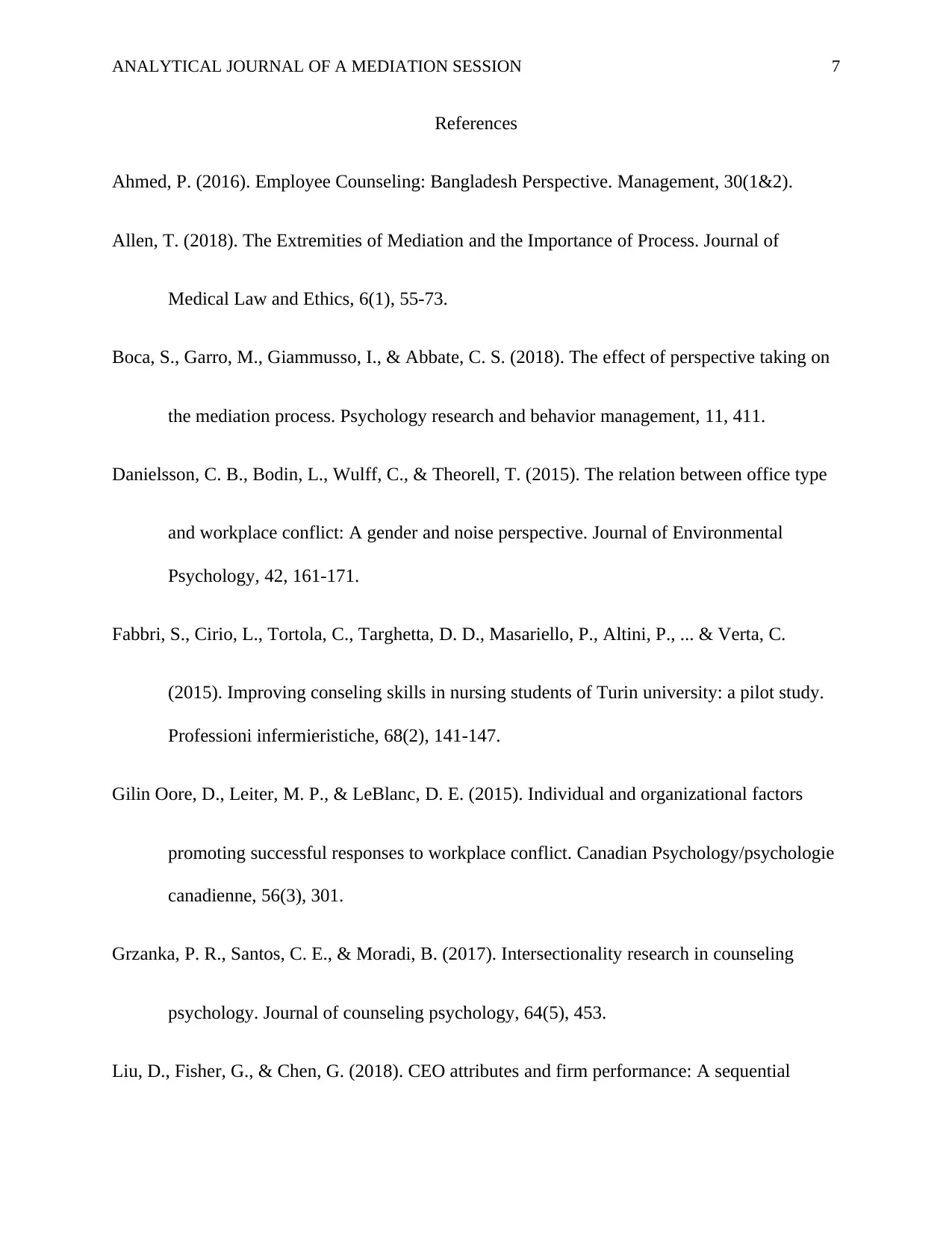
ANALYTICAL JOURNAL OF A MEDIATION SESSION 7
References
Ahmed, P. (2016). Employee Counseling: Bangladesh Perspective. Management, 30(1&2).
Allen, T. (2018). The Extremities of Mediation and the Importance of Process. Journal of
Medical Law and Ethics, 6(1), 55-73.
Boca, S., Garro, M., Giammusso, I., & Abbate, C. S. (2018). The effect of perspective taking on
the mediation process. Psychology research and behavior management, 11, 411.
Danielsson, C. B., Bodin, L., Wulff, C., & Theorell, T. (2015). The relation between office type
and workplace conflict: A gender and noise perspective. Journal of Environmental
Psychology, 42, 161-171.
Fabbri, S., Cirio, L., Tortola, C., Targhetta, D. D., Masariello, P., Altini, P., ... & Verta, C.
(2015). Improving conseling skills in nursing students of Turin university: a pilot study.
Professioni infermieristiche, 68(2), 141-147.
Gilin Oore, D., Leiter, M. P., & LeBlanc, D. E. (2015). Individual and organizational factors
promoting successful responses to workplace conflict. Canadian Psychology/psychologie
canadienne, 56(3), 301.
Grzanka, P. R., Santos, C. E., & Moradi, B. (2017). Intersectionality research in counseling
psychology. Journal of counseling psychology, 64(5), 453.
Liu, D., Fisher, G., & Chen, G. (2018). CEO attributes and firm performance: A sequential
References
Ahmed, P. (2016). Employee Counseling: Bangladesh Perspective. Management, 30(1&2).
Allen, T. (2018). The Extremities of Mediation and the Importance of Process. Journal of
Medical Law and Ethics, 6(1), 55-73.
Boca, S., Garro, M., Giammusso, I., & Abbate, C. S. (2018). The effect of perspective taking on
the mediation process. Psychology research and behavior management, 11, 411.
Danielsson, C. B., Bodin, L., Wulff, C., & Theorell, T. (2015). The relation between office type
and workplace conflict: A gender and noise perspective. Journal of Environmental
Psychology, 42, 161-171.
Fabbri, S., Cirio, L., Tortola, C., Targhetta, D. D., Masariello, P., Altini, P., ... & Verta, C.
(2015). Improving conseling skills in nursing students of Turin university: a pilot study.
Professioni infermieristiche, 68(2), 141-147.
Gilin Oore, D., Leiter, M. P., & LeBlanc, D. E. (2015). Individual and organizational factors
promoting successful responses to workplace conflict. Canadian Psychology/psychologie
canadienne, 56(3), 301.
Grzanka, P. R., Santos, C. E., & Moradi, B. (2017). Intersectionality research in counseling
psychology. Journal of counseling psychology, 64(5), 453.
Liu, D., Fisher, G., & Chen, G. (2018). CEO attributes and firm performance: A sequential
Paraphrase This Document
Need a fresh take? Get an instant paraphrase of this document with our AI Paraphraser
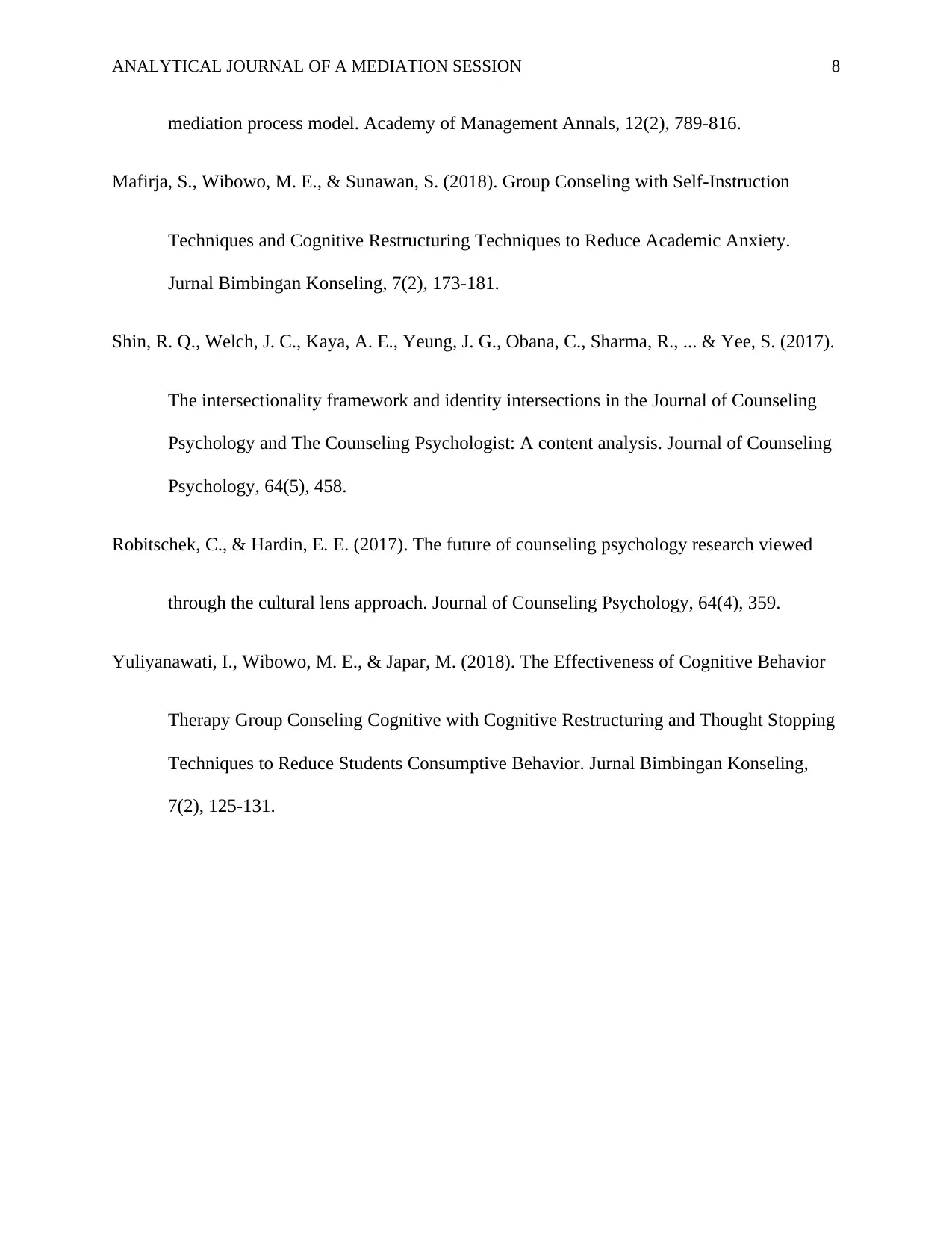
ANALYTICAL JOURNAL OF A MEDIATION SESSION 8
mediation process model. Academy of Management Annals, 12(2), 789-816.
Mafirja, S., Wibowo, M. E., & Sunawan, S. (2018). Group Conseling with Self-Instruction
Techniques and Cognitive Restructuring Techniques to Reduce Academic Anxiety.
Jurnal Bimbingan Konseling, 7(2), 173-181.
Shin, R. Q., Welch, J. C., Kaya, A. E., Yeung, J. G., Obana, C., Sharma, R., ... & Yee, S. (2017).
The intersectionality framework and identity intersections in the Journal of Counseling
Psychology and The Counseling Psychologist: A content analysis. Journal of Counseling
Psychology, 64(5), 458.
Robitschek, C., & Hardin, E. E. (2017). The future of counseling psychology research viewed
through the cultural lens approach. Journal of Counseling Psychology, 64(4), 359.
Yuliyanawati, I., Wibowo, M. E., & Japar, M. (2018). The Effectiveness of Cognitive Behavior
Therapy Group Conseling Cognitive with Cognitive Restructuring and Thought Stopping
Techniques to Reduce Students Consumptive Behavior. Jurnal Bimbingan Konseling,
7(2), 125-131.
mediation process model. Academy of Management Annals, 12(2), 789-816.
Mafirja, S., Wibowo, M. E., & Sunawan, S. (2018). Group Conseling with Self-Instruction
Techniques and Cognitive Restructuring Techniques to Reduce Academic Anxiety.
Jurnal Bimbingan Konseling, 7(2), 173-181.
Shin, R. Q., Welch, J. C., Kaya, A. E., Yeung, J. G., Obana, C., Sharma, R., ... & Yee, S. (2017).
The intersectionality framework and identity intersections in the Journal of Counseling
Psychology and The Counseling Psychologist: A content analysis. Journal of Counseling
Psychology, 64(5), 458.
Robitschek, C., & Hardin, E. E. (2017). The future of counseling psychology research viewed
through the cultural lens approach. Journal of Counseling Psychology, 64(4), 359.
Yuliyanawati, I., Wibowo, M. E., & Japar, M. (2018). The Effectiveness of Cognitive Behavior
Therapy Group Conseling Cognitive with Cognitive Restructuring and Thought Stopping
Techniques to Reduce Students Consumptive Behavior. Jurnal Bimbingan Konseling,
7(2), 125-131.
1 out of 8
Related Documents
Your All-in-One AI-Powered Toolkit for Academic Success.
+13062052269
info@desklib.com
Available 24*7 on WhatsApp / Email
![[object Object]](/_next/static/media/star-bottom.7253800d.svg)
Unlock your academic potential
Copyright © 2020–2025 A2Z Services. All Rights Reserved. Developed and managed by ZUCOL.





